|
|
TSSA today responded to Nicola Sturgeon’s announcement on the surge in Omicron cases in Scotland by urging Boris Johnson to reintroduce the furlough scheme.
The surge in Omicron cases has caused 60 ScotRail services to be cancelled today, and many staff at an A&E unit in Lanarkshire are isolating. Jason Leitch, National Clinical Director for Scotland stated that Omicron’s attack rate is 50% meaning that one covid positive person could infect 50 out of a hundred people in a single room.
TSSA General Secretary Manuel Cortes said, “The Omicron variant will soon become not only the dominant variant in Scotland but in the whole of Britain. It’s more contagious than any covid variant we have seen. We must act now to contain it.
“Sturgeon’s intervention today reinstating ten-day isolation on contact with the virus was welcome. But we are one island and to fight off the Omicron variant we need Britain-wide action. That’s why Boris Johnson needs to immediately reinstate the furlough scheme so businesses can send non-essential staff home without loss of income. This isn’t just about cancelling Christmas parties anymore, it’s about saving lives!”
 Islington Council has launched its biggest ever public engagement programme in a bid to explore local people’s experience of inequality and, with local communities, help build a more equal borough together. Islington Council has launched its biggest ever public engagement programme in a bid to explore local people’s experience of inequality and, with local communities, help build a more equal borough together.
Spearheaded by Council Leader Cllr Kaya Comer-Schwartz, the Let’s Talk Islington campaign will provide opportunities for people who live, work, and study in Islington to share their personal experiences of inequality and, together with the council, drive the change they want to see in the borough.
Let’s Talk Islington comes a decade after the Fairness Commission was created by Islington Council to interrogate how to make the borough a fairer place. The pioneering approach resulted in a clear vision to take the steps needed to create a fairer borough (see ‘About the Fairness Commission’ section below).
Now the Council seeks to lead the way once more in addressing some of the most complex challenges people face by putting the community firmly at the heart of its plans.
The Council wants to collaborate with residents to collectively develop and test solutions to complex issues such as disproportionate access to mental health services, the unequal effects of air pollution, and inequalities in educational attainment leading to a lack of opportunities for some of Islington’s young people.
From now until Spring 2022, the Council will work with the local community, voluntary sector, schools and others to facilitate and support a series of discussions, workshops, and creative activities, exploring in-depth how inequality affects life in Islington, and how everyone might contribute to creating a more equal future.
Let’s Talk Islington officially launches today in Caledonian Park, where Cllr Comer-Schwartz will meet with residents on a symbolic ‘conversation bench’ – one of four to be installed in parks across the borough, including in Whittington Park, Islington Green, and Spa Fields.
The Inequality Task Force
As part of Let’s Talk Islington, the Council has assembled an Inequality Task Force of civic, academic, and business leaders with a mix of expertise across health, poverty reduction, and education, both with locally-rooted expertise and from further afield, to bring new perspectives in tackling inequality.
All Task Force members have a wealth of experience in working in partnership with communities, putting people at the centre of our plans (see below for a full list).
Islington Council Leader, Cllr Kaya Comer-Schwartz, said: “Islington is a wonderfully diverse borough, but we know access to the opportunities on offer is far from equal. The Covid-19 pandemic has shone a light on the inequalities which already existed in our society and it’s more important than ever that we listen to local people, to better understand the impact of those inequalities and how best to challenge them.
“There is an immense opportunity, especially in the wake of Covid-19, for the Council to lead the way to a more equal future by actively seeking to understand individual experiences and priorities.
“We want our residents to take the lead, and to collaborate with us to design a new era of public service delivery. Old solutions won’t work for the new challenges and greater complexities we now face. The balance of power must shift to the people in our communities, to those who live these experiences every day and are key to creating a more equal future.”
Professor Donna Hall CBE commented: “Let’s Talk Islington is an innovative approach to tackling inequality and social injustice through community power. I’m proud to be a part of it because these are things I believe in passionately and I hope I can add value to the conversation with partners and citizens.”
The engagement period will culminate in a series of workshops in Spring 2022, in which residents, community groups, and local stakeholders will be invited to build on insights gathered and develop solutions to the challenges the community faces. This will inform the Council’s strategic planning and be presented back to the public in Autumn 2022.
Residents can read more and get involved by visiting: www.islington.gov.uk/letstalk
 SWARCO Smart Charging has been hailed as the Charging & Re-fuelling Infrastructure Provider of the Year at the prestigious GreenFleet Awards. SWARCO Smart Charging has been hailed as the Charging & Re-fuelling Infrastructure Provider of the Year at the prestigious GreenFleet Awards.
The ceremony, which was held on 1 December 2021 at the British Motor Museum in Warwick, celebrates environmental excellence in the fleet and transport sector, recognising innovation and progress from fleets themselves, as well as those – like SWARCO Smart Charging – who supply them.
This industry recognition for SWARCO Smart Charging, which is one of the UK’s leading providers of electric vehicle charging infrastructure and smart charging solutions, follows similar success in 2018 when SWARCO was also named Charging & Re-fuelling Infrastructure Provider of the Year.
This category recognises the efforts of vehicle charging and refuelling infrastructure providers and the progress made in rolling out low carbon infrastructure across the UK. SWARCO Smart Charging’s win is attributed to its ongoing commitment to supporting the expansion of electric vehicle (EV) charging networks that directly benefit fleet drivers.
Justin Meyer, Managing Director of SWARCO Smart Charging is delighted to see the efforts of his team and the results of its successful partnerships rewarded: “We are immensely proud to be working with those who are at the forefront of cutting transport emissions, and who share our passion for growing the right kind of EV charging networks that support fleets up and down the UK. Decarbonising transport is a collective effort, and I am pleased to see the work of our growing team recognised at an industry level and to be named as GreenFleet’s Charging & Re-fuelling Infrastructure Provider of the Year.
“We were one of the first infrastructure providers to the market in the UK,” he says, “and our growing team embodies the same drive and enthusiasm as it did from the very start. 2021 marked a new era for us with substantial new investment in both our team and the development and expansion of our proprietary technology and charging solutions. So we are delighted to have won this award for our work this year and very much look forward to 2022 with even more successful projects on the horizon.”
SWARCO’s successful projects in 2021 have included the completion of project PACE – a joint Lanarkshire and Scottish Power Energy Network’s (SPEN) project which adopted a new, innovative funding mechanism to rapidly deliver charging hubs in urban and rural communities and triple the charger availability in North and South Lanarkshire. Each hub is strategically placed to provide access for all, including commuters, fleet operators and residents.
SWARCO continues to support the E-Bus sector, with deployment of a cost-effective solution for charging and managing 32 fully electric double-decker E-Buses operating on Manchester City centre routes. The SWARCO solution supports the E-Bus fleet to carry out two key high frequency services connecting Manchester city centre, Manchester Airport, five hospitals and two universities – saving 920,000 litres of diesel a year and reducing annual CO2 emissions by 2,400 tonnes.
Having been appointed technology provider for the rapidly expanding Motor Fuel Group network, over the course of 2021, SWARCO is deploying over 200 150kW ultra-rapid chargers. SWARCO is also working with Transport for Wales and Welsh Councils to install charging infrastructure on multiple projects to help develop the strategic road network for Transport for Wales, a rapid charger hub for Carmarthenshire, and rapid chargers for the Cardiff City Region supporting EV Taxis. Similarly, SWARCO Smart Charging and Transport North East have gone live this year with a network targeted at the taxi and private hire market, taking into account extensive research into vehicle dwell times and the most popular pick-up locations. Other significant projects have included SWARCO Smart Charging solutions in Cambridge and Kent.
2021 has also been the year that SWARCO successfully completed what is globally the largest ever EV charging network migration, taking over management of the ChargePlace Scotland network in July. The extensive network includes 2,650 charging stations, 350 hosts and eight technology suppliers and the new dedicated ChargePlace Scotland team, which has been set up in Dundee, continues to make significant improvement in performance of the network and the driver satisfaction rating.
SWARCO Smart Charging has more than 8,500 commercial charge points installed across the UK.
The Conservative Party has been fined £17,800 by the Electoral Commission after failing to accurately report a donation and keep a proper accounting record.
The sanction was imposed on the party, following the conclusion of a detailed investigation. The investigation looked at whether any transactions relating to works at 11 Downing Street fell within the regime regulated by the Commission and whether any such funding was reported as required.
The investigation found that the party failed to fully report a donation of £67,801.72 from Huntswood Associates Limited in October 2020. The donation included £52,801.72 connected to the costs of refurbishment to 11 Downing Street. The full value of the donation was not reported as required in the party’s Q4 2020 donation report.
The Commission also concluded that the reference in the party’s financial records to the payment of £52,801.72 made by the party for the refurbishment was not accurate.
The investigation found that decisions relating to the handling and recording of this donation reflected serious failings in the party’s compliance systems.
Louise Edwards, Director of Regulation at the Electoral Commission, said:
“Our investigation into the Conservative Party found that the laws around the reporting and recording of donations were not followed.
“We know that voters have concerns about the transparency of funding of political parties. Reporting requirements are in place so that the public can see where money is coming from, inaccurate reporting risks undermining trust in the system.
“The party’s decisions and actions reflected serious failings in its compliance systems. As a large and well-resourced political party that employs compliance and finance experts, and that has substantial sums of money going through its accounts, the Conservative Party should have sufficiently robust systems in place to meet its legal reporting requirements.”
For the offence of failing to accurately report the full value of the donation from Huntswood Associates on 19 October, the Commission has imposed a sanction of £16,250. For contravening the requirement to keep proper accounting records, a sanction of £1,550 has been imposed.
Main findings of the investigation
On 19 October 2020, Huntswood Associates Limited transferred £67,801.72 to the Conservative Party. According to the evidence, Lord Brownlow, director of Huntswood Associates Limited, indicated that £15,000 of that was for an event. He specifically identified the remaining £52,801.72 as a donation to cover an earlier payment of that value made by the party to the Cabinet Office. The Cabinet Office had paid three invoices over summer 2020, totalling £52,801.72, for the refurbishment of the private residence at 11 Downing Street. Those payments were made on the basis of an agreement that the sum would be repaid by the party, which it was on 6 August 2020. The party anticipated being repaid by a proposed trust, which was under consideration but had not at that time been created.
On 27 January 2021, the party submitted its Q4 2020 donation report to the Commission. It reported receiving £15,000 from Huntswood Associates Limited. The party did not report the remaining £52,801.72 it received.
Our investigation, launched on 28 April 2021, considered whether the £52,801.72 was a donation and reportable to the Commission. We determined that it was, and should have been reported.
In the party’s financial records and accounts, the £52,801.72 it paid to the Cabinet Office was recorded as a “blind trust loan”. The payment was not a loan and the trust had not been formed, so such references did not accurately reflect the circumstances of the expenditure.
Lord Brownlow also paid directly to the supplier a number of additional invoices relating to the refurbishment, totalling £59,747.40. We considered whether these transactions met expenses incurred directly or indirectly by the party, which would make them donations under the definition in electoral law. From the evidence gathered, we were not satisfied that the party had agreed to meet these expenses or that Lord Brownlow’s payment was meeting a cost incurred by the party. They were therefore not judged to be reportable donations, and so we found no offences in relation to those payments.
 Tim Pitts By Tim Pitts, Senior Partner at Agilisys
The impact of the COVID-19 pandemic over the past 20 months has turned public sector organisations on their heads. Whilst some site that there has been a seismic shift in their digital thinking, others argue that the changes brought on by the pandemic were ones that public sector organisations should have made long ago.
Technology has been front and centre throughout the rapid digital transformation we have been seeing in the public sector. But as we move into the ‘new normal’ what are the areas of tech that savvy public sector CIOs will need to be focused on over the next 12 months and beyond?
- The changing role of IT
The barriers to digital transformation have come down. IT departments have been pivoting from being a function that’s about feeding and watering boxes and wires, to one which drives digital capabilities within the organisation.
In 2022, successful CIOs will increasingly recognise that the job isn’t just about looking after the infrastructure. They must think differently about where the organisation could go and what their leadership can do for them. Local authorities will continue to put tech leaders on the board as they realise they can’t pivot without having digital leadership properly challenging the business to re-think.
- The next phase of RPA
Many local authorities have already adopted robotic process automation (RPA) to remove time-sapping tasks within the organisation, so that staff can focus on more citizen-centred experiences. Thus far, RPA has been primarily used by business functions such as finance, HR, and IT. However, in 2022, data and risk management will become a core driver of RPA. Where you can use the ability of bots to not do anything unexpected it really plays to that compliance and audit aspect. Because they’re not going to deviate or do anything other than what they’re expected to, there’s a direct risk mitigation aspect to their role. I expect to see public sector organisations move tasks where human error could come into play, over to RPA in 2022.
- Driving forward experience through tactical digitisation
The digital transformation we are now seeing is more focussed on the way people are approaching problems versus the technology itself. With the increasing range of technological options now available, being able to connect services, data and citizen interactions is just a small part of what has been made possible. In 2022, local authorities will look at how they can better leverage the data they’ve got on a citizen to make their life simpler across all their future transactions. They will use the tools at their disposal to create a digital experience that all citizens have come to expect. The good news is that solutions today provide much lower cost methods of managing contact than traditional methods, while also delivering a significantly better customer experience.
- Using technology to accurately predict, pre-empt and pre-authorise
Demand for services have reached unprecedented levels at a time when resources have been stretched to their limits. Being able to automate decisions such as planning applications will be imperative. As will pre-empting and pre-authorising processes such as blue badges or parking to revolutionise the customer journey and automating the validation of care related services; removing weeks of uncertainty and hardship for many.
In 2022, digital leaders will increasingly look at information they have at their fingertips to understand where demand is coming from. Adult social care is a good example. Using data – and ideally working as part of an integrated care system – local authorities can understand what the demand is going to be by person. For example, they may want to know who ‘Molly’ is, when she is likely to hit the system, what support she will need and who is best placed to support her. This is where the world of the Internet of Things (IoT) and in-home tech solutions can really come into their own.
- Better harnessing the power of data

Organisations are starting to recognise the power of what can be done with data, but we are all still only scratching the surface. Think about the world of IoT and in-home tech solutions like sensors. By harnessing the power of these data sets, an authority could theoretically cut the number of adult social care workers, allowing a fundamental shift in the skillsets required within their teams. This could be very timely. It has always proven difficult to get good social care staff, and we are seeing this more so now with the lasting effects of the pandemic, Brexit and social care reforms. If these roles could be switched to data specialists, analysts and home tech specialists, public sector organisations could end up shifting the narrative and allow themselves the space to deal with a much wider range of challenges.
- Promoting wellbeing through technology
Across all industries, there is currently an acute need to manage staff wellbeing. Whilst there were plenty of issues before the pandemic, these have been intensified over the past year and a bit. Never has there been a better time to identify and measure where the biggest problems are and address them urgently. In 2022, technology will increasingly be used to help. One of its main benefits is that it takes emotion out of the equation. If decisions and plans are based on data, it is easier for businesses to remain objective and respond to the issues that have been identified as causing problems for the general productivity and wellbeing of their people.
- Moving into the cloud
To become a true digital enabler today you’ve got to move to the cloud. Most public sector organisations can’t afford the computing power to do proper machine learning to predict demand or understand how to communicate with people on an individual basis. Most of the money spent on innovation continues to be cloud based. Out of the hundreds of digital services released every quarter by all the big platforms, very few of them are now built with on-premises usage in mind. The big three cloud providers spent just under £70bn on development last year. That’s a figure all authorities need to be taking advantage of in 2022.
- The climate emergency will drive transformation
The climate emergency is, quite rightly, going to continue to be on everyone’s mind in 2022. Well over 300 local authorities have already declared a climate emergency and the recent COP26 summit monopolised headlines for weeks. Moving to the cloud is a no-brainer for local authorities with environmental aspirations. Plus, with all three big cloud providers declaring they’ll be carbon negative by 2030, let alone carbon neutral, it is yet another compelling reason to head to the cloud.
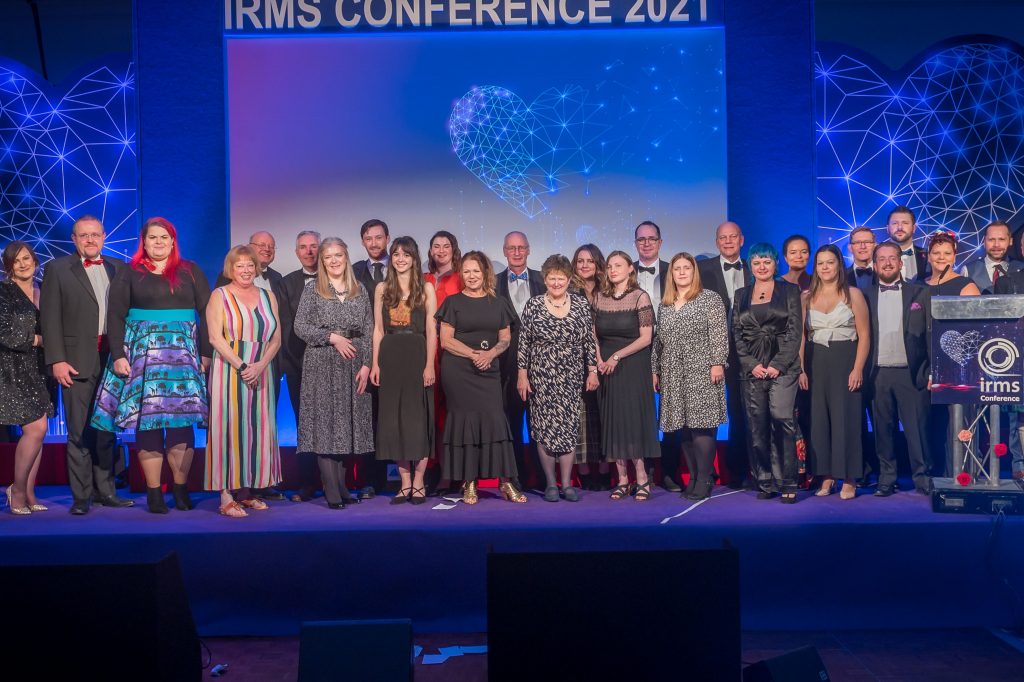 Society Recognises Excellence in the Field of Information Management Society Recognises Excellence in the Field of Information Management
The Information and Records Management Society (IRMS) has announced the recipients of its 2021 IRMS Awards. The prestigious and highly sought-after annual industry awards recognise excellence in the field of information management. The awards were presented at a Gala Dinner, sponsored by Iron Mountain, during the IRMS Conference 2021 in Birmingham on Monday 29 November.
The IRMS 2021 Award winners are:
- Information & Records Management Team of the Year: Dapian
- Innovation of the Year: Dapian Data Protection Impact Assessment Platform
- Alison North Award for New Professionals: Ewa Kapica
- Author of the Year: David Canning
- Supplier of the Year: Act Now Training
- Information & Records Management Professional of the Year: Rod Stone
- Special Recognition Award: David Smith
- Lifetime Achievement Award: Deirdre Allison
During the ceremony, co-hosted by Chair of the IRMS, Reynold Leming AMIRS, FIRMS and magician Ben Hanlin, the IRMS also presented Fellowships to Anne Barrett, Simon Ellis, Rod Stone and Suzy Taylor, with an Honorary Fellowship given to Gavin Siggers. Fellowship is the most senior level of IRMS membership. It is awarded to those members of ten years or more who have, in the opinion of their peers, attained appropriate eminence, authority or seniority.
Reynold Leming states: “Congratulations to all our worthy award winners and a very warm welcome our new IRMS Fellows, all of whom have demonstrated best practice and excellence in their field. They are true ambassadors for the information and records management industry and our Society.”
Registration is open now for the IRMS Conference 2022, which takes place in Glasgow from 15 till 17 May and will focus on the theme ‘Resilience, Recovery and Renewal’ www.irmsconference.org.uk
New figures show small businesses exported over £99bn in 2019, up £700m on the previous year
Currently only 1 in 10 small businesses export, as the Trade Secretary encourages SMEs to take up Government offer of support and sell their products to the world
Small businesses across the country are in prime position to seize the opportunities of new trade deals and help the UK become an exporting superpower, the Trade Secretary says today.
On Small Business Saturday, Anne-Marie Tnrevelya heralds the power of small businesses and encourages them to take up recently revamped Government support for exporters, so they can sell more of their first-class products around the world.
New figures released this week show small businesses exported over £99bn of goods and services in 2019, up by more than £700m from the previous year.
However, only 1 in 10 small businesses were selling their products overseas, with just over 228,000 small businesses exporting goods and services in 2019.
International Trade Secretary Anne-Marie Trevelyan said:
“From the high street to the web, small businesses are at the heart of our economy. It is great to see so many are reaping the benefits of exporting and we want to see them go even further.
“Just 1 in 10 small businesses currently export, so we’re boosting our support to give them direct, tailored advice to help them on their exporting journey. Many of these businesses are in prime position to take advantage of the trade deals we are negotiating, and can play a vital role in helping the UK reach our Race to a Trillion.”
Last month DIT published a 12-point Export Strategy – titled ‘Made in the UK, Sold to the World’ – to help get more businesses selling more products to more countries, so the UK reaches one trillion pounds a year in goods and service exports.
Alongside the Strategy, DIT hosted International Trade Week, which featured 20 SME-specific events providing expert, tailored advice to over 1,000 registered companies who attended.
More than 1,000 businesses have also already signed up to the newly-expanded UK Export Academy, which offers free, comprehensive training for SMEs to learn how to sell to customers and secure contracts around the world with confidence.
 Digitising hospitals was the focus of NHS IT policy for twenty years. The job is still unfinished: so what are the options for trusts – and the integrated care systems that are planned to take over health tech strategy and funding next April? The Highland Marketing advisory board asked three leading chief information officers for their views. Digitising hospitals was the focus of NHS IT policy for twenty years. The job is still unfinished: so what are the options for trusts – and the integrated care systems that are planned to take over health tech strategy and funding next April? The Highland Marketing advisory board asked three leading chief information officers for their views.
Covid-19 and the latest reforms of the NHS have focused attention on health tech to an unusual degree. The first few months of the pandemic saw a rapid roll-out of remote working, virtual clinics and digital-first primary care and triggered a lively political and media debate about their future role in healthcare.
Meanwhile, the health tech market has been focused on integrated care systems and the shared care records, data platforms, and apps they will need to join-up services, introduce population health management, and create a new ‘offer’ for places and citizens.
In the middle of all this, the digitisation of hospitals seems to be in danger of being overlooked. Which is odd, because for 20-years it was the focus of NHS IT policy, and it is still far from complete.
In comments to the HETT show at Olympia, reported by the Health Service Journal, NHSX chief executive Matthew Gould around 10% of trusts remain “largely paper-based” while there are “a whole lot more that are only semi-digitised.”
With the global digital exemplar programme wound down, the Unified Tech Fund planning to allocate the last of Jeremy Hunt’s tech money by March, and ICSs due to take over IT strategy and funding in April, it doesn’t look like there’s a central strategy to improve things.
Yet, as the ‘What Good Looks Like’ document for ICSs acknowledges, there is a need to ‘level up’ trust electronic patient record provision, if hospitals are to work efficiently, support their staff, and feed into those shared care record and data platforms.
So, the Highland Marketing advisory board asked three leading chief information officers what their trusts are doing, to inform a debate about the challenges and opportunities ahead.
Big box? Best of breed? Ecosystem? Or new thinking?
Adrian Byrne, the chief information officer of University Hospitals of Southampton NHS Foundation Trust, started by challenging some of the terminology that is used around hospital systems.
Traditionally, he noted, people have contrasted ‘big box’ or single supplier with ‘best of breed’ models for rolling out EPR functionality, such as patient administration, order comms, e-prescribing and, more recently, e-noting and e-observations. But this may be unhelpful and outdated.
Unhelpful, because even the biggest of ‘big box’ EPRs don’t do everything, so trusts are going to have to integrate them with other systems at some point; and the real question may be how much integration they want to handle.
“There seems to be an idea that it’s ‘go with one of the big boys’ or ‘let chaos reign’, but I don’t subscribe to that,” Byrne said. “We are said to have a best of breed approach, but we want to integrate where we can and get down to as few systems as possible.”
Outdated, because most of the current discussion about EPRs is focused on how they are evolving into platforms that can collect and then flow data into different systems, including patient-facing apps.
“I spoke to Will Smart [the former CIO of NHS England, who now works for Dedalus] a couple of weeks ago,” Byrne said, “and he didn’t want to talk about EPRs anymore. He wanted to talk about platform, flowing data, and patients: and I think that’s right.” (Highland Marketing also spoke to Will recently, and there’s more on his views here).
Hospital IT is like an onion…
In practice, the basic distinction is well understood. Martin Sadler, the chief information officer at Sandwell and West Birmingham NHS Trust, said his organisation “put in an EPR 18-months ago” and “it has given us a platform to say: ‘this is what we have done to the patient’ and ‘this is where they are in our system’.”
Whereas Neil Perry, director of digital transformation at Dartford and Gravesham NHS Trust, said that in 2017, when his organisation refreshed its IT strategy, it first “decided what it wanted to do” and then decided that “best of breed was the way to get there, fastest.”
But there was agreement between presenters and advisory board members that it is not enough.
Since then, his trust has adopted a modern approach to integrating data from its different systems and re-exporting it to apps that ‘fill gaps’ in its EPR functionality, working with an open platform from Alcidion.
However, there was agreement between presenters and advisory board members that an EPR, however, developed, is not enough.
Sadler said that while his trust had deployed Cerner Millennium, this was not the end of its IT strategy. Perry showed a slide that set out his strategy as an ‘onion’ with core functionality at its centre, and open, innovative systems for e-prescribing, analysis, and remote patient monitoring in the outer layers.
“An EPR is important, but to my mind, in our onion, it will be doing the core stuff and around the edge will be all the really exciting stuff: and that’s more or less what Will says,” he said.
Options, pros and cons
Bearing this in mind, the presenters and advisory board members felt there were pros and cons to the two approaches that less mature trusts will need to consider. A single supplier approach can get trusts a long way fast: one vendor pitches its system as “HIMSS 4/5 out of the box.”
There is a perception that this makes ‘big box’ the preferred option for NHS England, which picked a lot of single supplier trusts for the GDE programme, and NHSX, which has structured the digital aspirant funding and the UTF around a PAS plus EPR modules approach.
It’s also understood by boards. Neil Perry said one of his challenges was getting new leaders to understand his strategy. “You get the board asking why we don’t have an EPR, or why we don’t go and buy Cerner or Epic,” he said. “Regulators can also be a challenge.”
On the other hand, a single supplier approach is expensive. Sadler said his trust chose to retain its patient administration system and running Cerner Millennium still costs half his IT budget.
There is also a danger of trusts deploying their ‘out of the box’ EPR functionality and getting stuck at its level. The GDE programme was set up to take trusts in this position to the top of the HIMSS EMRAM maturity model and to create a ‘blueprint’ for others to follow.
It worked for the trusts involved; but many of Gould’s “semi-digitised” hospitals will be running systems they got around the time of the National Programme for IT, with a bit of e-prescribing and e-observations, for which there has been national money.
So, perhaps the biggest argument for ‘best of breed’ these days is that it can encourage innovation. Perry said that as part of its 2017 strategy reset, his trust decided that “we didn’t just want to be an early adopter, we wanted to be right on the left-hand side of the adoption curve, in the red zone, working with start-ups and innovators.”
Byrne’s team has developed its own technology, including the My Medical Record personal health record that is being quite widely adopted, particularly for prostate cancer follow-up (the Highland Marketing advisory board has been following the progress of MyMR, and there’s more information here).
Challenges and opportunities
Parking the current lack of national focus, why haven’t more trusts made similar progress? Board-level support and funding are definitely issues. Sadler said that in his previous CIO role, at young fashion website Missguided, his IT budget was 22% of turnover. The three presenters estimated their budgets at 2-4% and said they needed 6-10%.
But it’s not just money. Cindy Fedell, a former NHS CIO who now works in Ontario, said people were also an issue. “You need a good CIO, who can understand strategy and understand their options,” she said; arguing that more should be done to support professionalism and certification initiatives.
Then, there’s local politics. James Norman, another former NHS CIO who now works for Dell Technologies, said when it comes to collaboration across a health economy, two of the potential reasons trusts go out to tender are that they’ve been formed in a merger, and it’s easier to pick a “compromise” system than it is to get people to work with each other’s IT, or they want to be on a different system to their neighbour/s to stop a merger happening.
Although Sadler said he’d have been happy to use a neighbour’s technology; if they weren’t trying to charge so much that it wasn’t an option. “All of that needs to stop,” Norman argued. “We should be working together as one NHS and sharing ideas and skills and systems.”
ICSs: a chance to level up to where the best are now, not where the GDEs were five years ago?
In the absence of a national strategy, one of the questions for the future is going to be how integrated care systems approach the job of drawing up IT strategies for their trusts and patches.
Byrne argued there is a danger that some could be tempted to bring in management consultants who will advise buying a new kind of ‘big box’ – a single EPR for trusts, with a health information exchange / analytics package / patient portal attached.
Which, he argued, was likely to be a bad idea because it would mean swapping out one v1.0 system for another v1.0 system. As an alternative, he outlined a three-pronged approach.
First, a proper evaluation of the level of digital maturity that trusts have achieved for the money they have spent, to identify best-practice and where best to allocate ‘levelling up’ funds.
Second, ICS or ICP-led, system-wide procurements in areas where these make sense: pathology, imaging, areas like maternity that are not covered by EPR functionality and have a strong patient component. And third, system-wide integration of existing IT, so organisations can exchange messages with each other and with patient facing technology.
“I think it has to be an evolutionary approach,” he said. “If people have some digital maturity, they should keep going, and keep thinking about how to build on those foundations. And it has to be clinically-led.”
Nicola Haywood-Alexander, the CIO for the Lincolnshire integrated care system, said she was hoping to develop a strategy around this kind of idea. “I want to build up an architecture across the ICS,” she said. “Instead of asking: ‘does this hospital need an EPR’ I want to ask: ‘what do we need across the system?’
“That way, we can use investment to support new kinds of thinking. A lot of work that is done in hospital at the moment is going to be done in the community or homes in the future. So, we need to look at what works in hospital and ask how we can get it into the community or homes.
“Then, with a bit of luck, we can get the aspirants to where the best people are now, and not where the GDEs were five-years ago.”
 Highland Marketing’s advisory board: Jeremy Nettle, former global advisor for Health Sciences, Oracle Corporation; Cindy Fedell, former chief digital and information officer at Bradford Teaching Hospitals NHS Foundation Trust; Andy Kinnear, former director of digital transformation at NHS South, Central and West Commissioning Support Unit; James Norman, healthcare CIO, EMEA, at DellEMC; Ravi Kumar, health tech entrepreneur and chair of ZANEC, and Rizwan Malik, divisional medical director of Bolton NHS Foundation Trust and managing director of South Manchester Radiology Highland Marketing’s advisory board: Jeremy Nettle, former global advisor for Health Sciences, Oracle Corporation; Cindy Fedell, former chief digital and information officer at Bradford Teaching Hospitals NHS Foundation Trust; Andy Kinnear, former director of digital transformation at NHS South, Central and West Commissioning Support Unit; James Norman, healthcare CIO, EMEA, at DellEMC; Ravi Kumar, health tech entrepreneur and chair of ZANEC, and Rizwan Malik, divisional medical director of Bolton NHS Foundation Trust and managing director of South Manchester Radiology
Highland Marketing is an integrated communications, PR and marketing consultancy with an unrivalled reputation for supporting UK and international health tech companies and healthcare providers, built over almost 20 years. Read more analysis and interviews on the Highland Marketing website, follow us on Twitter @Highlandmarketng, or get in touch on: info@highland-marketing.com
 By Sascha Giese, Head Geek™ at SolarWinds By Sascha Giese, Head Geek™ at SolarWinds
For years, it has been broadly accepted that the profile of open-source software as ‘higher risk’ goes against the principles of public sector technology procurement. Being free, not reputedly as safe, and via smaller vendors than the big players, has blinkered this industry to finding solutions which could be a better fit for the organisation.
Yet the digital age has done tech pros a favour by making open-source databases more widely accessible, which means it’s too good an opportunity not to explore. Public sector IT pros find themselves in the unenviable position of calculating the total cost of ownership and comparing open-source databases with commercial solutions.
Challenges for Database Managers
The realities of adapting to flexible workspaces and hybrid working introduces a new element of complexity for database managers, along with compliance and governance issues, ever-increasing data volumes and the need to process this data. Add to this the hybrid IT reality and the growing number of databases tech pros must manage. The scale of these pressures is evident in the latest SolarWinds Query Report, in which almost one-third of tech pros surveyed say they manage more than 300 databases at their organisations. And for most respondents, at least half of their organisation’s databases are in business-critical use.
Another factor driving public sector organisations towards being more broad-minded on open source is the increased need to work with various types of database platforms. This relaxation in brand loyalties has been a by-product of the digitalisation of the pandemic and is a result of the need for speed in deploying applications.
To move forwards at pace, many technology teams now typically buy their applications instead of building their own. The type of database is often dictated by a preferred database from the vendor, which is either relational or non-relational (the so-called NoSQL data platforms), and it can be open-source or commercial.
Commercial platforms still dominate—especially for business-critical applications—but open-source databases are absolutely on the rise. We’re at the beginning of a new era of mix-and-match data platforms, but there are some key considerations before investing in an open-source platform.
Does Being Free Have to Come at a Cost?
If open-source databases are free, should this raise concerns that something else has to give? When compared against the price tag of commercial software licensing fees, this subscription is a significant cost saving for IT budgets. It frees up budget spend for experimentation and increases the speed for IT projects to progress.
The open-source free license model levels the playing field for small organisations to access equally innovative features as their larger counterparts. With the added advantage of being smaller, less bureaucratic, and nimbler in decision-making, smaller public sector organisations aren’t at a disadvantage to improve their technology at speed.
Until recently, government and public sector organisations have been preoccupied with the legal implications and consequences and accountability, despite its free and accessible up-sides. Ongoing tech support is a concern open-source database manufacturers have addressed, due to patch-fixing and other historical concerns.
As any IT investment, weighing up cost versus value of open source is the biggest dilemma. A commercial tool may potentially save thousands of pounds a year in efficiencies and ongoing support, in which case the licence fee pays for itself. And when it doesn’t deliver, your contract will ensure maintenance fixes and professional support.
In contrast, the low-cost database platform may not be as sophisticated, but the clear cost savings make it an option for the organisation. To take a middle ground, technology specifiers can select the most common and well-vetted features of an open-source database platform to minimise risk while taking the financial perks. Commercial enterprises such as Red Hat, Debian, and Percona can be contracted with to navigate the minefield of issues and bugs which can come up in an open-source database platform.
The increasing popularity of open source is undeniable and snowballing. Forty-three percent of tech pros surveyed in the aforementioned report say they run MySQL or MariaDB. A further 18% say they plan to adopt MySQL, MariaDB, or another open-source database platform in the next three years.
There are some potential issues to be aware of before rushing headfirst into open source. The tooling isn’t always as sophisticated, and open-source platforms require insider knowledge to make them work as you need them to, beyond a basic level. For a business-critical application, it may be advisable to wait for better tooling.
Moving Forward With Choosing Open-Source Databases
Typically, the first question to address when selecting an open-source database is the required performance and workload capabilities of the platform. This must factor in the wider issues of security and compliance, which must run through technology in public sector organisations, and the cost or licensing on occasion.
It’s vital to ensure a dedicated team is in place to scope out the project, backed by the most senior database professionals in the organisation and the CTO. However, time to commit to this process is often an issue, as database managers are always busy with perhaps over 300 databases. This makes it a challenge to prioritise, but a vital one for innovation and development.
Our report shows the pressure tech pros are under to find time to investigate open-source databases or analyse potential productivity gains and cost savings. One-third of those surveyed said database maintenance takes up the majority of their daily tasks.
Benefits of Automated Monitoring
A key solution for freeing up tech pros’ valuable maintenance time and tech budget is to implement optimised automation using database monitoring tools. Monitoring tools run in the background, flagging issues before they become critical, perhaps even in real time, and quick fixes can be made to avert wider problems. Automation of database monitoring allows database professionals to focus on proactive database performance management, to include innovation, training, and scoping out open-source options. It’s the most effective way to manage hundreds of databases.
Just as for any private company, adopting a database monitoring mindset will be the key success factor for any public sector organisation IT strategy. Monitoring methods are a given when procuring a database platform, to ensure it can’t break without them knowing about it. Monitoring ensures all the processing cycles on a particular server and acts as insurance against bigger issues.
Lining up the team and creating time to scope out open-source databases will open options for what’s suitable for a public sector organisation. But before deploying one, it’s important to consider all options and potential risks, as well as the functionality versus the priority level of business application. And when installing the new database platform, remember automation and monitoring provide excellent support.
For those starting out or in early stages with an open-source database platform, the landscape is improving, and proper tooling will follow. If you’re still thinking about it, jump on the open-source train before you get left behind.
 Barley Laing, UK Managing Director at Melissa The Pandora Papers have focused attention on the sometimes questionable and corrupt practises of the politically connected and super wealthy.
They highlight how important it is for the public sector to have access to international sanctions lists or watchlists from governments and regulators of persons who are prohibited from certain activities and industries as part of their know your customer (KYC) and anti-money laundering (AML) checks. A key part of this is obtaining data on politically exposed persons (PEPs).
In the UK, organisations have a legal requirement to undertake enhanced checks of both domestic and foreign PEPs. Doing so helps public bodies to avoid the possibility of hefty fines and brand damage resulting from the negative publicity associated with having someone already known to the authorities fraudulently claiming benefits or other services.
It’s not easy to identify PEPs due to the lack of a universally agreed definition of what constitutes one. The Financial Action Taskforce (FATF) defines a PEP as ‘an individual who is or has been entrusted with a prominent public function’. They are typically heads of state, government ministers, MPs, senior members of the judiciary, those on the boards of state-owned companies and central banks, and senior civil servants.
It’s important to realise it’s not enough to identify PEPs, as their relatives or close associates (RCAs) may also be involved in abetting possible fraudulent behaviour, so they must be screened for too.
There are several best practices for sourcing watchlists that contain PEPs and their RCAs:
- Obtain data from trusted global sources
To effectively screen watchlists use an automated tool that collects and synthesises data from a wide range of trusted sources worldwide, such as government, regulator and credit agency. One that also continually scans for updates. It will significantly streamline the screening process and ensure those with access to it are constantly updated on any changes to a user’s status.
- Undertake adverse media checks
To remain up to date on any new information on the status of an existing PEP who maybe using your services, augment the standard PEP screening process with adverse media and negative news checks. Such a tool scans the global news media and sources the names mentioned in the likes of the Pandora Papers, as well as news on those with new sanctions against them and where there’s legal cases pending.
- Take a risk-based approach to watchlist screening
With budgets stretched it’s important to take a risk-based approach to watchlist screening, particularly with PEPs and RCAs. Investment should be focused on implementing enhanced due diligence measures for high-ranking PEPs and their RCAs, including those in territories where there’s a greater prevalence of corruption.
- Continue to evaluate risk when a PEP leaves office
‘Once a PEP, always a PEP’. It’s a good attitude to have. While someone who has departed the political arena may not pose the same level of risk they once did, they still may continue to have some risk associated with them. Once a PEP leaves office, consider risk factors such as their time in the post, extent to which they are politically connected, their continuing degree of influence and their country’s level on a corruption index.
- Access an automated solution as part of a wider automated AML activity
An automated solution that identifies those on disparate watchlists, including PEPs and RCAs, in real time, works well as part of a more comprehensive automated approach to KYC and AML. Use electronic identity verification (eIDV) that can cross-check – in real time – the details provided by the user against reputable data streams to ensure they are who they say they are. Also, when onboarding, document scanning with optical character recognition (OCR) and machine readable zone (MRZ) technology should be used to enable public bodies to immediately determine the authenticity of the ID documents provided online.
The Pandora Papers underline why public bodies must obtain a comprehensive list which has access to high-quality watchlists, in particular PEPs, from governments and regulators worldwide – one that also continually scans for updates. The list should also have automated functionality so it can be easily used in conjunction with automated eIDV and document scanning technology for an accurate, fast, and cost-effective KYC and AML process.
For more information about Melissa and how our ID and document verification services can help you prevent fraud please visit: www.melissa.com/uk, email: barley.laing@melissa.com or call: 020 7718 0070.
 Bristow & Sutor win industry award for Webio partnership – photo by Tangerine Photography. The Midlands-based enforcement specialist was nominated for three categories at the Credit & Collections Technology Awards, held at the Midland Hotel in Manchester on Thursday 4th November. Alongside technology partners Webio, Bristow & Sutor were victorious in the Digital Business Transformation category and were shortlisted for the Innovation in Collections & Recoveries and Best Use of Technology awards.
The Credit & Collections Technology Awards recognise, excellence and innovation in the UK credit and collections industry. These awards celebrate solutions and innovations in lending, credit and collections through a range of categories related to technological needs and support.
Bristow & Sutor has over 42 years of experience in the collection of local council tax, non-domestic rates and unpaid Penalty Charge Notices (PCNs). The business partnered with Webio last year to implement WhatsApp Business API as an inbound channel for people in problem debt, providing more opportunities for customers to reach out and find a resolution.
Webio uses the power of conversation AI to automate and blend chatbot and live agent-customer conversations across a multitude of messaging channels. Conversation threads capture chat history and remain open 24 hours a day, which improves the quality of responses and ensures key information is logged and accessible whenever someone chooses to engage.
The enforcement firm predicted that many customers would feel more comfortable discussing their circumstances on message-based platforms as this removes any embarrassment associated with directly speaking about debt. This would also aim to be a useful tool for overcoming barriers such as anxiety or vulnerability. It was anticipated that allowing customers to instigate conversations and questions would have positive outcomes, especially on channels where debtors already feel relaxed, comfortable and safe.
Since adopting this updated technological approach, engagement from customers has grown to over 160,000 messages every month. Due to this success on WhatsApp, Facebook Messenger has recently been added to the Bristow & Sutor Webio platform as well, with the same chatbot and automation flows applied.
Emma Watson, Head of External Communication at Bristow & Sutor, said, “Our first aim is to give customers relevant answers to queries on topics including balance confirmations, payment dates, and complaints in an efficient way and on platforms they know and feel comfortable using. 78% of messages received over the past year did not require human intervention to be resolved and consequently, Bristow & Sutor agents can now handle three times as many cases compared to responding via standard web chat. We are incredibly proud of the results we have seen since partnering with Webio and we are delighted to both receive this award and recognition from our peers.”
 Susan Venables, founder and client services director at Highland Marketing The NHS has already made a commitment to become the first net zero health and care system in the world. It’s time for digital health vendors to think about their role – and to be ready to talk about how they are tackling global heating, says Susan Venables, founder and client services director at Highland Marketing.
Living in the highlands of Scotland, it’s been impossible to miss the build up to Cop26. Cop26 is just an hour and a half away, and it has been preparing for the UN Climate Change Conference of the Parties for months.
Over the weekend, the news has been dominated by the arrival of the ministers who are supposed to agree the next steps on implementing the Paris Agreement and the pressure groups that are seeking to influence them.
For the next two weeks, Glasgow will be a riot of international debate, protest, and trade fair as the world looks on and asks the big question: it is going to be possible to deliver Paris and limit global warming to below 2 and preferably 1.5 degrees Celsius, in comparison with pre-industrial levels?
Climate change and the NHS
It’s a big challenge, and one that matters to the NHS. Partly, that’s because it could see a big increase in demand if temperatures continue to rise. Public Health England reckons 2,500 people died in last year’s heatwave alone.
Partly, it’s because the health service itself accounts for 4-7% of the UK’s greenhouse gas emissions, depending on whether you look at the carbon generated by its day-to-day operations or the many things associated with them, from food to patient travel.
The NHS is aware of this. In June 2019, Newcastle upon Tyne Hospitals NHS Foundation Trust became the first provider to declare a climate emergency. Since then, others have followed suit, including the mega-trust in Manchester and big name-hospitals in London.
NHS England has also picked up the baton. In October last year, its former chief executive, Sir Simon (now Lord) Stevens issued a report urging the NHS to become “the world’s first carbon net zero national health system” by 2040. That’s in less than twenty years.
Procurement will drive change, ready or not
I think health tech vendors need to sit up and take note of all this. Climate change is on the government and the NHS policy agenda. It’s already flying with influential trusts; and all NHS trusts will have to have a green plan by the end of the year.
The climate and health agenda will get another boost when England’s integrated care systems start work in April, because they have a population health remit and they will be working with local authorities that already have to consider the economic and social impact of their work.
Plus, when you look at the crowds gathering for Cop26, or the audience for net zero sessions at health events, it’s obvious that the climate and health emergency engages a younger, more diverse audience than most government, health or even digital issues do.
That means that health tech vendors need a good story to tell. In the short term, if you have a well-grounded, well-evidenced message, you are going to have a valuable differentiator in the market, and one that will resonate with a new and different audience for what you have to offer.
In the medium to long-term, having that message is going to be essential to protect your reputation and to continue to work with the NHS. From April 2022, every NHS tender will have a 10% net zero and social value weighting.
From April 2023, all NHS tenders worth more £5 million will require bidders to have published a carbon reduction plan, just to be considered. After that, the technical and procurement requirements on the NHS England roadmap only get tougher…
Tips for getting your climate message out
I don’t claim to be an expert on how health tech suppliers can demonstrate their contribution to keeping people well in a warming world, or on how they can calculate their contribution to the NHS carbon footprint, or their own carbon footprint.
The Highland Marketing advisory board is holding a special meeting towards the end of Cop26 to discuss these issues with expert input from David Newell, the head of health at Gemserv. But, as a head’s up: this is not about reducing a few travel miles or planting a few trees!
There are some gnarly things to get into, from thinking about how your data centre is powered, to working out how to provide support in a world where jumping on a plane is no longer an option, to examining the waste and working conditions in your supply chain.
Where I can claim to be an expert is in thinking through how companies need to present themselves to the health and care sector and how make sure that influencers and customers receive that information in the most effective way possible.
So, as a starting point, here are some basic tips for suppliers that want to start thinking about how they can build net zero into their marketing and public relations:
- Make sure this is on your agenda. Look at the NHS England plan and its subsequent presentations, think about what is being asked of health tech suppliers, and what positive impacts that will have on your business.
- Collect evidence. If you are engaged in a project that has a measurable impact on addressing the health impacts of climate change or reducing the carbon footprint of the NHS, make sure that you are capturing that information.
- Share success. If you’ve done a great piece of work and you can prove it, a compelling press release or case study will raise your profile and demonstrate your credentials to potential customers and their increasingly engaged, increasingly savvy end-users.
- Join the conversation. Cop26 is capturing headlines and NHS net zero plan is getting attention, but there has been relatively little commentary on the role of health tech. So, there’s an opportunity to shape the agenda through blogs, opinion pieces, podcasts and social content.
- Prep for media opportunities. Both the mainstream media and the specialist health and tech press is starting to write about net zero. A well-briefed spokesperson ready to engage at short notice could secure you national press coverage that doesn’t come along all that often.
The moment is now
Cop26 has really focused attention on climate heating. Hearing about the science and seeing the passion of the many young people who are pouring into Glasgow has made me realise that now is the moment for all of us to start thinking about how we can take action.
I want to be completely clear that I am not suggesting to health tech vendors that this is a great bandwagon to jump on or that they should have a friendly green message. Suppliers need to take a good, hard look at the carbon impact of their activities and to make a start on a plan for reducing that.
The other reason that now is the moment is that NHS England has published one of the most ambitious plans in the world for a net zero health and care system and is creating technical and procurement strategies to deliver on it. Companies can seek to influence those plans by showing the change they are making; or get caught up in change that is happening anyway.
Here at Highland Marketing, we always say we are looking for ‘health tech to shout about’. Increasingly, a commitment to net zero and social responsibility is going to be one of the things that health tech vendors are going to need to shout about; and that the NHS and its users will be expecting to hear.
Highland Marketing is an integrated communications, PR and marketing consultancy with an unrivalled reputation for supporting UK and international health tech companies and healthcare providers, built over almost 20 years. Read more analysis and interviews on the Highland Marketing website, follow us on Twitter @Highlandmarketng, or get in touch on: info@highland-marketing.com
Dr. Jo Foster, Director of The Institute for Research in Schools, believes girls studying and working in Science, Technology, Engineering and Maths (STEM) is a cause to celebrate and not one for complacency. Rightly so. In her 13th August 2021 article for Schools Week in this topic, she suggests that the increasing success of girls in GCSE science may lead girls to choosing to pursue STEM subjects, and perhaps even STEM, careers further down the line.
She however says this remains to be seen, and yet she adds: “We know from our research that carrying out real science research as part of the curriculum is motivational for students and teachers alike. It increases their enjoyment and makes young people more determined to pursue a career in STEM.”
“Despite years of interventions to encourage women into STEM careers, the gender difference within the workforce remains consistent across age groups; 29 per cent of 16–29-year-olds in STEM are women, and 28 per cent of 30–49-year-olds.”
Role models are an important way to inspire women into STEM learning and STEM careers. Teachers should therefore highlight women who’ve done well in these disciplines – both from the past such as Marie Curie – the Polish-French physicist, and from the present such as Dame Sarah Gilbert – the lead scientist of the Oxford- AstraZeneca Covid-19 vaccine.
Foster therefore comments: “We know it is important for girls to encounter examples of women who have succeeded in STEM careers for them to choose the same. And equally important is providing young people with opportunities to take part in and experience real research. Teaching science without it is like teaching football and never allowing the aspiring players onto the pitch.”
Job security
Sylvia Lim, at teacher at Robert Clack School in Dagenham, finds that girls are very much attracted to STEM subjects – particularly where the fields of STEM are conscientious in nature. Job security is another factor that decides which part of a STEM career they choose. “Often girls in STEM are interested in pursuing medicine, dentistry, pharmacy and the like”, she says. However, she has noticed that there isn’t much motivation amongst girls “to study STEM out of the desire to study engineering, mathematics or physics.”
Teachers’ support
There are organisations that have developed programmes to support women wanting to teach STEM. Teach First is one of them. Georgia Mumby, Storytelling Manager for External Relations at the organisation describes Lim: “She is a brilliant Science teacher who completed the Teach First teacher training programme in 2018. She is passionate about passing on her enthusiasm for the female scientists and teachers she looked up to during school and when studying Biology at university.”
In June 2021, Teach First published a report, ‘STEMinism: One year on’, which provides insights into how businesses can support schools and pupils to encourage them to take up STEM subjects and career – with a particular focus on inspiring girls. It discusses the ongoing challenges of improving women’s representation in STEM sectors. In fact, the report cites a TeacherTapp poll of 6,943 teachers, which was conducted on 11 March 2021, and which finds that “98% of teachers agree that schools should help break down gender stereotypes relating to subjects and careers.”
Teach Computing is therefore working in collaboration with the Raspberry Pi Foundation; STEM Learning; BCS, The Chartered Institute for IT; the Behavioural Insights Team, Apps for Good and WISE on the Gender Balance in Computing (GBIC) research programme “to find out what works to encourage girls to develop an interest during their primary and secondary school years, and to increase the number of young women who choose to study Computer Science at GCSE and A level.”
Girls’ confidence
However, there is more to do than offer STEM programmes to girls and young women. Girls’ confidence appears to be an obstacle. Philippa Hodgson, Graduate Software Engineer at IT firm Bridgeworks explains:
“In Year 7 and 8 girls are confident, but Year 9 it’s a different story as they begin to care about what other people think. There is a stigma with STEM topics as they don’t want to be seen as being nerdy. Rather than having a whole group of girls in science in Year 7, there would be just one Year 10. One girl was nervous that the boys would mock her in a science. She became more confident when I sat to talk with her and encouraged her to contribute. The boys were very supportive.”
Her colleague, Sarah Potter, Test Team Lead at Bridgeworks, concurs: “There is a confidence problem that some girls and young women have that steers them away from STEM subjects.” When she went to school, particularly with regards to IT, there were no women teachers. However, in other science and maths areas, she says there was a better mix. There were nevertheless fewer female role models, and so she stresses it’s vital to up women role models to look up to.
7 top tips for inspiring girls
So, given these challenges, what are their 7 top tips for inspiring girls into STEM learning? They are as follows:
- Offer an open dialogue with pupils, from a very young age (even in primary school) discuss the wide variety of STEM careers and expose pupils to many different STEM careers from the get-go. Schools need more funding for things like science club and teachers also need to be given time and funding to support girls in exploring endeavours such as engineering projects or robotics.
- Provide and highlight female role models – including STEM teachers and women working in a diverse range of STEM careers – not just the obvious ones. Lim says it’s important to note that female STEM teachers at primary, secondary and in tertiary education can be fantastic role models for pupils. Inspiring girls to study STEM topics starts from day one of Primary School, and they need to be encouraged throughout their school life. It’s also very inspirational if the teachers have had STEM careers in industry. One of Lim’s teachers had a former career in biomedicine, while another was a biochemist. “They really made me think about where STEM could take me in life”, she says.
- Encourage girls and women to reach their full potential, suggests Potter: “From my own experience women are more likely to aspire to a more middle area where they feel a bit safer. One of the things I faced at school was being told to not apply to the top university, focusing instead on the ones I could get in rather than the ones I might get in.”
- Offer girls a more rounded education each year, covering a range of topics including STEM. When I was at a primary school, computers weren’t much of a thing, and it was very much dependent on what the teacher was interested in.
- Try to encourage girls to attend STEM clubs, says Hodgson as they give them the time for creativity to explore the topics. With most girls wanting to join subjects they feel more comfortable with, such as Art and Design, there is a job to do to show them that they can thrive with STEM – and enjoy it.
- Make science fun and explain the link to the science. Teachers will often do fun scientific experiments, but they could do more to reinforce the link to, for example, Newtons Laws used in this – this could be used in engineering jobs such as in Formula1.
- Offer better careers advice at school and college. Hogdson reveals she had very little career advice, and yet she advises girls to: “Be open to different possibilities and engage with universities, as well as to different areas of work. From an early age, knowing the possibilities would be better too. After all, not everyone will become a medical doctor.
Self-belief and opportunities
Potter concludes that the key to inspiring girls into STEM learning and careers has to be founded on teaching girls to believe in themselves – making them realise that STEM is a huge discipline. She explains: “There are so many areas they could go into. I joined Bridgeworks as a software developer, but I’ve gone into testing, but it wasn’t one I knew much about. When I was growing up, I looked at being a doctor, but I didn’t know things such as medical research, which might have interested me as a career.”
Hodgson thinks a new-found confidence can be created and instilled in girls by teachers’ enthusiasm for STEM, and that there is a need to remove any stigma associated with girls studying STEM topics. Over the next 5 years she would like to see more equality. She explains: “Whilst it’s improving, there is still a big divide between male and female students. I would like to see a bigger promotion of careers and jobs in the STEM sector. I was lucky to go with some students to a technology fair, but it only happened in Year 12 and so there was only a limited number of girls being introduced to these jobs.”
Hodgson concludes that while there has been a move in the right direction, there is no use in doing one STEM day a year at school or college. STEM has to be an all-year-round topic. Furthermore, with supportive STEM teachers who are willing to listen, to motivate and to address their pupils’ concerns, girls will be inspired into STEM learning and into successful future STEM careers. Amazing teachers have the skills to make change happen, and they can inspire both genders equally.
Published with thanks to Teach-Now – teach-now.co.uk/
By Graham Jarvis, Freelance Journalist
 Sascha Giese, Head Geek™ at SolarWinds By Sascha Giese, Head Geek™ at SolarWinds
2021 has been another year of challenges for us all, and for the IT sector, the changes needed, time invested, and adjustments made to public sector systems and processes are set to shape the future for good. While private sector businesses focused on survival, the public sector had to contend with pressure not only to keep afloat, but to keep the public safe and informed, and work towards a mass vaccination operation across the country.
For IT departments, enabling staff to continue working remotely has been key, as virtual working looks to take hold well beyond the pandemic. Adapting systems and developing solutions to help prevent the continuing spread of the virus has meant IT professionals, once again, have become the real unsung heroes of the public sector.
Recognising the relentless and stoic efforts of these workers in recent months, SolarWinds sought to glean a better understanding of the IT professional’s experiences, across a range of sectors with our IT Pro Day 2021 survey: Bring IT On.
Our annual survey questioned global technology professionals from within the SolarWinds user community and highlighted the changing face of the IT landscape in the rippling wake of the global crisis.
What the Numbers Revealed
Questioning 287 IT professionals—including IT generalists, software engineers, developers, and security professionals—across the globe, the SolarWinds IT Pro Day 2021 survey revealed several insightful findings.
Unsurprisingly, the global health crisis has led to an exponential change for IT professionals, but one of the most favourable outcomes arguably has been a change in attitude towards their discipline. Of the tech pros who responded to the survey, 48% said they were proud of what they do, 44% love what they do, and 41% claimed this year has proven they’re more capable than they realised. The survey revealed an overwhelmingly positive perception of the role of the tech professional, and many look forward to what lies ahead; a staggering 81% of respondents said they believe there will be multiple opportunities to develop and enhance their careers in the next year.
As more than two-thirds (67%) of the respondents said they expect their level of responsibility at work to increase over the next year, career progression seems to be a key focus for many. When it comes to personal development, it seems IT personnel are increasingly beginning to recognise the need for nontechnical, softer skills that can be learned in daily life. Sixty-six percent of tech pro respondents reported collaboration skills (such as teamwork, listening to others, and networking) as the most important nontechnical skills necessary for advancement. Respondents also said the following experiences at home or in general daily life are perceived as most useful at work:
- Time management (e.g., prioritisation, organisation; 69%)
- Communication skills (verbal and nonverbal; 67%)
- Interpersonal skills (e.g., adaptability, flexibility, patience; 66%)
- Problem-solving (65%)
These less technical capabilities are set to play a key role in facilitating a range of responsibilities such as project management and more senior-level decision making, which 34% claimed was their biggest opportunity in the next year.
Tech professionals are anticipating further positive change when it comes to IT operations, with a prevalent focus on cybersecurity. With 53% of respondents citing cyberthreats as the biggest challenge they expect their organisation to face in the next year, they also stated that their organisations’ IT operations will evolve into the “next normal”, with prioritised investments to address the following challenges:
- Implementing new tools and processes to better address security, compliance, and risk (68%)
- Adding more collaborative technologies (44%)
- Adopting next-generation IT operations solutions (40%)
Looking to the “Next Normal”
As long as the health crisis lingers, public sector IT professionals will have their work cut out, carving a more agile, reactive infrastructure for organisations to better serve the public. Having weathered the peak of the COVID-19 storm (it’s hoped), IT professionals have been the unsung heroes, working in the background to prepare for a more virtual workplace in the future and facilitating digital transformation on an exponential scale.
Looking to the “next normal” as the public sector evolves, tech pros have rightfully become an indispensable, more highly respected part of the wider operations, finally receiving the kudos they deserve, and gaining momentum to become more central and integral to the progression and advancement of their sector.
by John Price, Head of Public Sector at Check Point Software UK&I
There’s nothing quite like a global pandemic with legally enforceable lockdowns to expose a demographic’s dependence on digital infrastructure. While the devastating SolarWinds breach in late 2020 made headlines around the world for its impact on corporations like Cisco and Microsoft and their thousands of customer organisations, the bad actors involved would have likely seen the private businesses impacted as collateral damage in pursuit of a much more lucrative target – the public sector.
The wheels of government have a reputation for turning slowly. Many governments, including the UK, are seen as overstretched, under-resourced in their response to potentially devastating cyber incidents. Take the WannaCry attack, for instance, which brought the NHS to a virtual standstill in 2017 because of unpatched and outdated software which took months to rectify. The government even had a £5.5 million deal in place with Microsoft to maintain support for the nearly two-decade-old Windows XP operating system long after it had fallen into obsolescence, which many would argue was an incident waiting to happen.
According to research from Check Point Software, there are 378 cyberattacks a week in the UK and government organisations have become the third most targeted sector by cyber criminals over the past six months, ahead of finance, banking, manufacturing and healthcare. Threats such as triple extortion ransomware and supply chain attacks are on the rise, with malware such as Trickbot, Dridex, Qbot and IcedID surfacing more frequently, as outlined in Check Point’s Cyber Attack Trends: 2021 Mid-Year Report.
Any hopes that lessons may have been learned from this breach have been dashed this year as the widely reported Microsoft Exchange hack continues to cause problems within the public sector. Despite the vulnerabilities being identified in January 2021, with patches circulating as early as March, more than 50% of MS Exchange servers in the UK remain vulnerable at the time of writing, including those on the British government’s ‘gov.uk’ domain. The public sector is, regrettably, a relatively easy target, but is it a lucrative one? Why are we seeing an increased number of bad actors targeting the public sector as we navigate our way through a global pandemic? As is often the case when it comes to malicious cyber actors, it’s a question of following the money.
What’s your data worth?
Data has value. It can therefore be extorted or sold on for profit. If a group of bad actors were to steal thousands of people’s credit card details by hacking into a private organisation such as a bank or online retailer, they’d fetch around £15 per record if auctioned off on the dark web. If, however, the same group were to attack an NHS trust and steal medical records, their potential profit would soar and net them more than £350 per record. And that’s not even taking into account the amount they could extort from the targeted trusts themselves. This isn’t helped by the fact that public sector organisations are often comprised of siloed data behemoths, so if a malicious actor is able to exploit a gap in their defences, the ‘pay-outs’ are often huge. As seen in the case of the MS Exchange and WannaCry incidents outlined above, responses to breaches in the public sector are often incredibly slow and poorly orchestrated, giving cybercriminals an even larger time window in which to exploit their targets.
Think resourcing, not outsourcing
Unlike in the commercial world, public sector organisations aren’t profit-driven and can’t easily justify the increased IT spend as a mere preventative measure. A year after the WannaCry attack, the government agreed a £150 million deal with Microsoft to equip all NHS computers with the latest Windows 10 operating system and ensure that all security settings were up to date. This is all well and good, but it took a catastrophic breach that put individuals’ medical records at risk to get budget approval. The public sector is, almost by definition, reactive instead of proactive when it comes to digital transformation. It’s there to serve, not to profit, and this leaves it vulnerable by default.
Part of that vulnerability is no doubt due to loss of control through third-party outsourcing. On the face of it, the cyber capabilities of the public sector and its employees are stronger than some of these incidents might suggest. According to the government’s annual report ‘Cyber security skills in the UK labour market 2021’, the public sector is actually surprisingly confident when it comes to performing advanced cyber security tasks. While a quarter of all businesses say they aren’t confident when it comes to penetration testing, for instance, more than 80% of public sector organisations are more than confident in their testing abilities. Similarly, 1 in 10 of all businesses say they lack confidence when it comes to user monitoring, but no public sector organisations report any such issue.
It’s only when we read further into the report, we start to see the real problems emerge. A quarter of public sector organisations have just one staff member responsible for cybersecurity and the percentage of public sector organisations outsourcing basic security functions such as firewalls, user privileges and backing up data, for instance, far outweighs that of the private sector. More than 95% of all public sector organisations outsource their firewall configurations to a third party; more than 80% rely exclusively on third parties when it comes to incident response and recovery; and almost half (48%) even outsource the control of internal user admin rights which, unless they have a very close relationship with their third-party IT partner, could have devastating security repercussions. So while the public sector might be confident in its cyber capabilities, that confidence might be ill-placed.
Good money after bad
In case you haven’t spotted it, the common theme here is a lack of internal resource and control. The technology is available, but only if the public sector is willing to continue putting up with the ‘technology debt’ it’s accruing through its overdependence on outdated internal tech and external cybersecurity solutions. According to a recent cabinet office report, keeping outdated computers going is costing the government roughly £2.3 billion per year, which is almost the same as the US government’s entire cybersecurity budget for 2021.
With a threat landscape that’s currently outpacing many private organisations’ capabilities, governments need to start thinking very carefully about their cyber security budgets, how much of their security solutions are outsourced, and how they can increase their risk posture in 2021 and beyond without continuing to throw good money after bad.
Check Point Software recently hosted a webinar entitled: “The State of Cybersecurity: Public Sector 2021” with experts from the field of cyber security in the public sector. To access the webinar on demand visit: www.brighttalk.com/webcast/16731/504417
 Peoplesafe Alert Technology-led employee safety specialists, Peoplesafe, has launched a new mass notification tool designed for instant communication with employees in a crisis. Peoplesafe Alert is a simple, intuitive app which allows organisations to send and track mass safety messages to thousands of employees simultaneously, overriding phones set to silent or do not disturb and, if necessary, using geofencing capabilities to only communicate with those in a certain location.
Designed to be used in any crisis situation, the Peoplesafe Alert tool can be operated in real time and messages cannot be edited or forwarded to protect the credibility of the organisation and guarantee that the information is current, correct and constantly controlled.
With its own dedicated platform, the app can sit on multiple devices and operating systems which guarantees that the priority messages will cut through any other conflicting or distracting messages at the time of an emergency.
Although UK based, the Peoplesafe Alert app is available in all countries, meaning that employees can be targeted by country if required. This also means that messages can reach employees no matter where they are in the world when a crisis unfolds. When sending a communication, administrators have the ability to tailor the message to the recipient’s native language.
The tool is fully compliant with BS 22301 and the encrypted service is delivered from ISO27001 certified data centres which guarantees that an organisation is meeting regulatory standards for business continuity.
Emergency situations where Peoplesafe Alert would come into play include; extreme environmental events such as flooding or an earthquake, cyber-attacks, network security, control and access issues (such as recently seen with the outage of WhatsApp, Facebook and Instagram) and outbreaks of infectious diseases.
This marks an expansion for the technology company, which has previously focussed on lone worker safety and protection products and services. Peoplesafe CEO Naz Dossa said: “While the experience of steering employees through the COVID-19 pandemic is still fresh in everybody’s mind, we need to look ahead and guarantee that business continuity will not be compromised in the face of any future emergencies.
“Technology has been absolutely crucial in keeping employees informed, safe and (in the most part), able to deliver their work. However, given that the pandemic was an unprecedented situation, lessons have been learnt. Peoplesafe Alert’s instant, precise mass notification abilities will enable an organisation to communicate effectively with all, or some of their employees depending on the emergency.
“As technology safety experts with many years’ experience, we are in a prime position to assist our customers so that they can both take care of their employees in a crisis and maintain business continuity using next generation communications.”
Peoplesafe Alert licenses can cost as little as £1 per user, per month, offering a scalable solution that can flex with the requirements of the organisation.
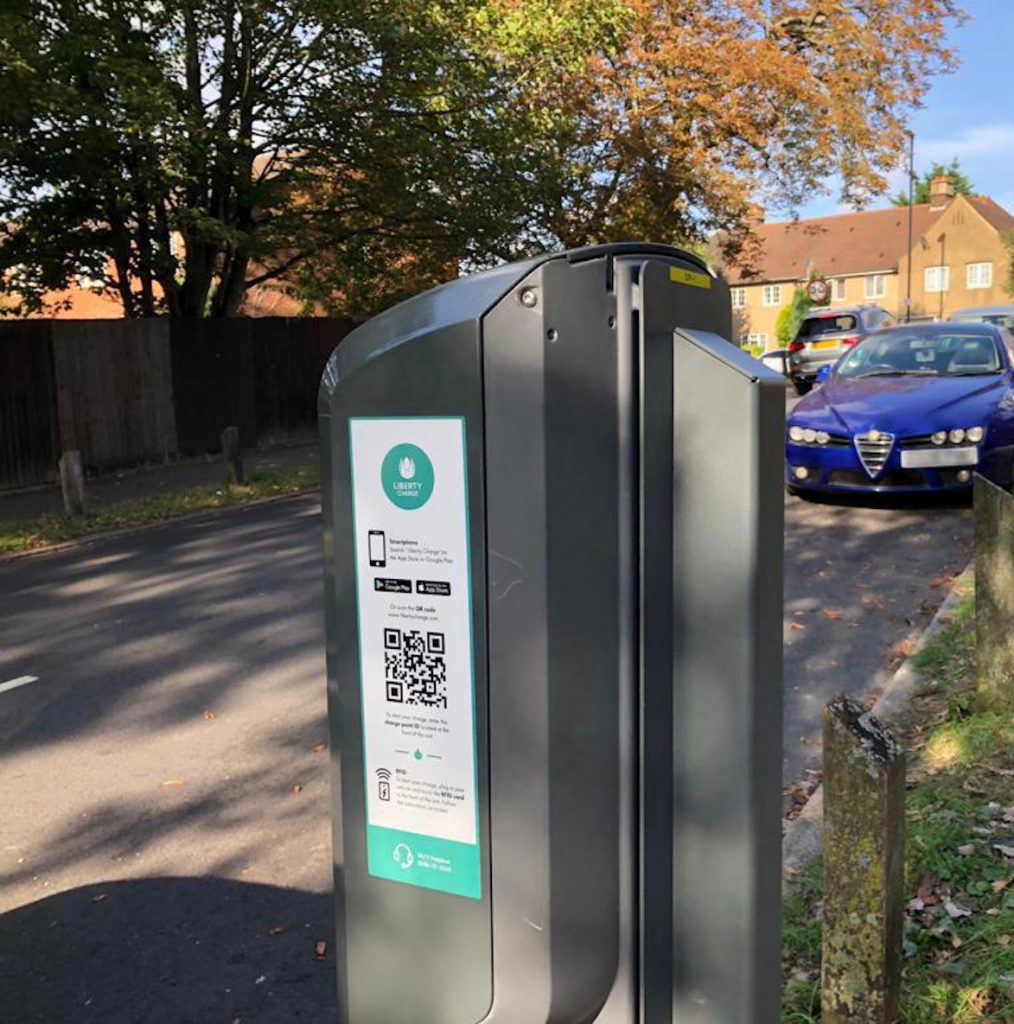 Liberty Charge – new charge point operator Liberty Charge chose the public sector and local government event, Solace Summit, to launch as a Charge Point Operator (CPO), committed to tackling the chronic under-supply of easily accessible on-street charging in the UK.
With 40% of the UK’s urban residents having no access to off-street charging on a private driveway, Liberty Charge will provide fully-funded charging facilities on-street to help Councils meet a very clear public need and support their local sustainability and clean air targets.
Working in partnership with local authorities, Liberty Charge takes on the ownership and cost of running and maintaining the EV charging stations, as well as the supporting infrastructure on which they rely.
In collaboration with its delivery partner, Virgin Media O2, it will roll out an initial 500 electric vehicle charging sockets across five UK local authorities by the end of 2021. The initial roll out will include the London boroughs of Croydon, Hammersmith & Fulham and Wandsworth. It will also include West and North Northamptonshire Councils, to help address the significant deficit of on-street charging outside the capital.
Currently, there are approximately 5,700 on-street charge points across the UK, the majority of which are in London, with only 1,000 outside the capital. Liberty Charge will be focused on accelerating this roll out in a bid to help meet one of the Government’s net zero goals of installing more than 120,000 EV charge points by 2025. This will also help accelerate the UK’s transition from fossil fuel powered vehicles to electric vehicles, as the Government works to phase out the sale of combustion powered cars by 2030.
Neil Isaacson, CEO, Liberty Charge, says with the current roll-out rate, the Government’s target is a challenge: “Local authority budgets are already under pressure and they often lack the capital expenditure to undertake such an investment,” he says. “By providing a fully-funded, reliable and convenient on-street solution, we can help local authorities make this national target a reality.”
Neil says there are currently 11 million UK households with no driveway and no way of charging their vehicle off-street: “With our strategy, and the support of our delivery partner, we can plug a huge gap in the market,” he concludes.
The Solace Summit took place between October 11 – 15 as a hybrid event, part virtually and part in-person at the Bonus arena in Hull.
 Reflections in the glass structure of the new, enlarged ticket hall at Victoria Underground station Transport for London’s (TfL) payroll team is saving 160 days’ administration time per year, thanks to the introduction of a secure online portal that automates the production and distribution of payroll and HR documents.
The secure online portal not only helped to enable the remote working necessary during lockdown but is also facilitating the long-term trend towards hybrid working which has accelerated over the last 18 months. According to the *Office for National Statistics, in future, 24% of UK businesses intend to use increased homeworking and 85% of adults currently homeworking want to adopt a hybrid approach.
TfL is the integrated transport authority responsible for the day-to-day operation of London’s public transport network and the management of its main roads; it employs over 26,000 staff across multiple locations.
Until early last year, TfL’s payroll team used to print and post – via internal mail and Royal Mail – over 400,000 payslips, P60s and P45s annually. The process was time-consuming, expensive and environmentally unsustainable.
The organisation approached leading provider of secure document automation solutions, Datagraphic, with a remit to deliver Epay, its secure online portal that automates the production and distribution of payroll and HR documents.
The solution has allowed TfL’s payroll team to adopt a 100% digital operation. This has saved them 160 days annually in administration time previously spent printing and distributing payslips, P60s and P45s, and enabled them to focus on higher-value tasks, adding further value to the organisation. They no longer need access to corporate printing equipment and so can work anywhere.
It has also resulted in savings on resources such as paper, allowing TfL to cut costs and work with a greater degree of environmental sustainability.
Employees can securely access their payroll documents remotely via any internet enabled device from any location at any time. As Epay works with TfL’s existing systems, employees only need to sign in once via their established rewards platform to access all their employee documents. This ease of access has improved the employee experience and resulted in an increased level of employee engagement.
Said TfL’s employee payments delivery lead, Colin Turner: “Using Epay, we have saved time and money, which means our payroll team can focus on more value-added activities.”
Added Datagraphic’s managing director, Glyn King: “Document automation increases the efficiency of payroll operations and is supporting the trend towards remote and hybrid working that accelerated during the pandemic.”
Last year, Datagraphic became a supplier on Crown Commercial Service’s (CCS) G-Cloud 12. Its solutions can now be purchased without going to tender, via the government’s CCS-managed G-Cloud 12 digital catalogue. The company is an SME, so by working with Datagraphic, public sector clients such as Network Rail, Leeds City Council, East Sussex Council and Surrey County Council, as well as TfL, are helping to meet the government’s target of spending £1 in every £3 with small to medium sized enterprises by 2022.
Epay swiftly facilitates document automation without system changes or capital outlay and can reduce the time spent on manual and repetitive document processes by up to 98%. It doesn’t charge license fees, with a pricing model based on the number of documents uploaded and distributed rather than the number of employees. Return on investment is delivered in months rather than years.
While the solution is “digital first”, it is also capable of securely generating and delivering printed documents as required.
Epay clients include public sector organisations such as Network Rail, Leeds City Council, East Sussex Council and Surrey County Council, and private sector companies including Specsavers, Airbus, Sodexo and H&M.
For further details about Epay or to arrange a demonstration, please visit datagraphic.co.uk or call 01246 543000.
*Office for National Statistics: Business and Individual Attitudes Towards the Future of Homeworking, UK: April to May 2021
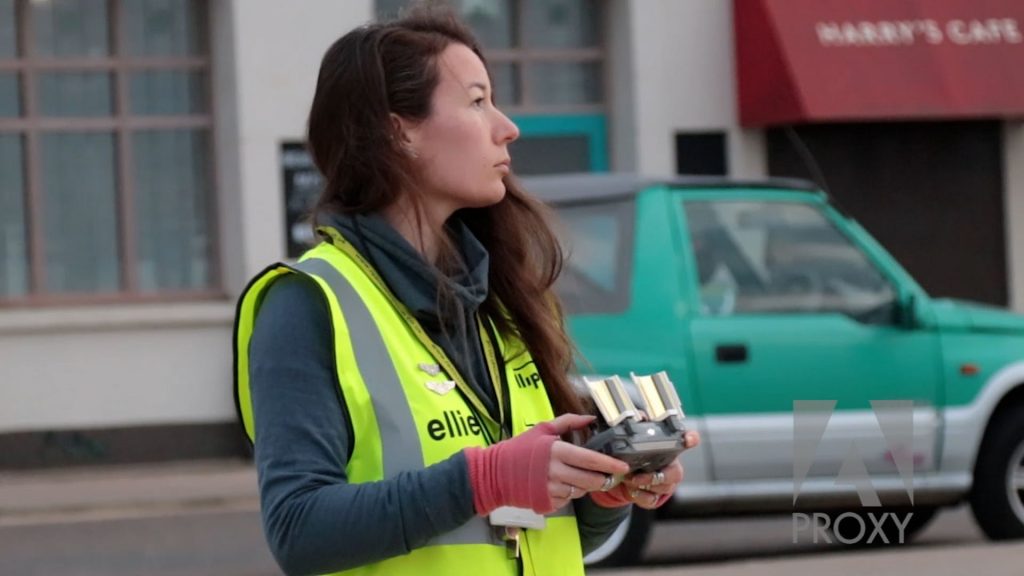 Ellie Mackay, Ellipsis Earth CEO, flying drone – photo: Ellipsis Earth The most scientifically robust litter survey ever undertaken in the UK has revealed that positive, playful environmental messaging can cut litter and reduce plastic pollution. By creating bins that had positive, engaging messaging and strategically placing them in litter hotspots a 75% decrease in littering was achieved. In contrast negative and hectoring messaging increased littering by 10%.
The pioneering use of drone and AI technology was led by scientists at Ellipsis Earth. They undertook three sets of drone flights over Bournemouth, Christchurch and Poole creating a detailed map of every bit of litter dropped in the surveyed areas including beaches, town centres and green spaces. Surveys took place during the March lockdown, over the late May Bank Holiday weekend and finally during August Bank Holiday weekend.
The charity Hubbub used the data collected in May to implement a range of anti-littering campaigns built around proven behaviour change campaigns. In parallel the council ran their traditional communication campaign with more aggressive messaging. Results were measured by the August survey.
The interventions that proved most successful with residents and visitors in Bournemouth were the glow-in-the-dark bins, which saw an 88% reduction of glass bottle and aluminium cans littered in the vicinity, and ballot bins, where an average reduction of 73% of cigarette butts was recorded, when placed in targeted locations.
Other findings from the trial, revealed:
- The east side of Bournemouth Pier (where multiple interventions were placed) saw a reduction in litter of 79%. The west side (where no interventions were placed) had zero reduction
- Large brightly coloured bins helped reduce litter in Bournemouth Lower Gardens by 89% when they were brought in to supplement existing small closed bins which had previously been the worst performing bins in the region
- Ballot bins attached to lampposts (where people answer a question by depositing their cigarette end) placed in targeted locations showed an average reduction of 73% of cigarette butt litter
- All other existing council bins across Bournemouth and Poole showed no decrease in litter
- In Christchurch and in all the other beaches in the area where no interventions were put in place there was also no decrease.
Where negative and accusatory messaging was used, there was a 10% increase in litter in areas near this signage, suggesting that negative messaging doesn’t prompt positive behaviour.
The data also indicated that a fundamental change in strategy is required to cut plastic pollution reaching the sea. One of the largest forms of littering were small plastic fragments. Food outlets along the Bournemouth beachfront sell takeaway food in disposable polystyrene containers. Many are left on the beach to be pounced upon by seagulls searching for food scraps. The containers break into tiny plastic fragments which are blown or washed into the sea. This type of pollution would be ended if outlets were obliged to use reusable containers with a deposit repayable when returned. The solution exists but policy leadership by the council is required to make it happen.
The data illustrated that a surprising number of beach toys such as buckets, spades and inflatables were left littered on the beach. These are relatively cheap and can be cumbersome to carry so clearly some people think they are not worth the effort of removing. A solution might be to create a rental service for these items on the beach front. Not only could this cut littering it would also reduce the hassle of buying and lugging awkward items around which are only used infrequently.
Bournemouth rightly prides itself on world class beaches. The pristine sand is cleaned early every morning before visitors arrive. However, significant levels of litter are dropped in the late evening by people partying on the beach. Invariably this litter is washed into the sea before the early morning clean. Shifting cleaning routines to just before High Tide would prevent plastics reaching the sea. This is harder for the council to organise and potentially more expensive, but currently they are allowing the problems to be literally washed away.
Above everything, the campaign illustrated the significant value of high-quality data to inform decision-making. Based on the information provided councils could create more focussed litter prevention strategies, place bins where they are most needed, refine messaging in hot-spot areas, target resources more efficiently and work more closely to reduce littering.
By Chris Hampton, Product and Business Development Manager – Hydrogen, at BOC UK & Ireland
 Council Guide to H2 Councils and local transport authorities (LTAs) are well-positioned to take a leading role in de-carbonising the UK’s transport system. By updating transport fleets to use zero emissions vehicles, councils can lead by example and, even more importantly, put the infrastructure in place to enable others to follow suit. Councils and LTAs should carefully consider their options for decarbonising transport. The decisions they make today could affect the choices available to other fleet operators tomorrow.
Where to start?
‘Where to start?’ is one of the most common questions asked by councils and LTAs. To answer that and more, we’ve compiled a simple guide, available here: BOC’s Guide to Decarbonising Transport with Hydrogen Hubs.
The hydrogen advantage
Hydrogen fuel cell vehicles offer some key advantages over battery electric vehicles. They offer a fast and familiar refuelling process, which is comparable to today’s petrol and diesel vehicles. Hydrogen vehicles also offer good range (typically 350-500km) from a single refuelling. A further benefit is that hydrogen suits big and heavy vehicles that would otherwise require heavy batteries to power them. These characteristics make hydrogen an ideal fuel for buses, refuse trucks, road sweepers, gritter lorries, delivery vans and other vehicles in daily use with the ability to return to base for refuelling. All of these vehicle types are running on hydrogen today.
From small to large scale
BOC offers modular refuelling stations that enable customers to start small and grow their infrastructure with increasing demand. If you operate a small fleet of vehicles but you want to benefit from the economies of scale that come with producing higher volumes of hydrogen, BOC can help you join forces with other users to build a shared refuelling facility with a larger vehicle usage. Scaling up can dramatically reduce the price of hydrogen.
Hydrogen is a strategic focus for the UK government and as a result there are a range of funding sources available to help finance your project. BOC is also able to help finance the capital cost for high-volume refuelling hubs.
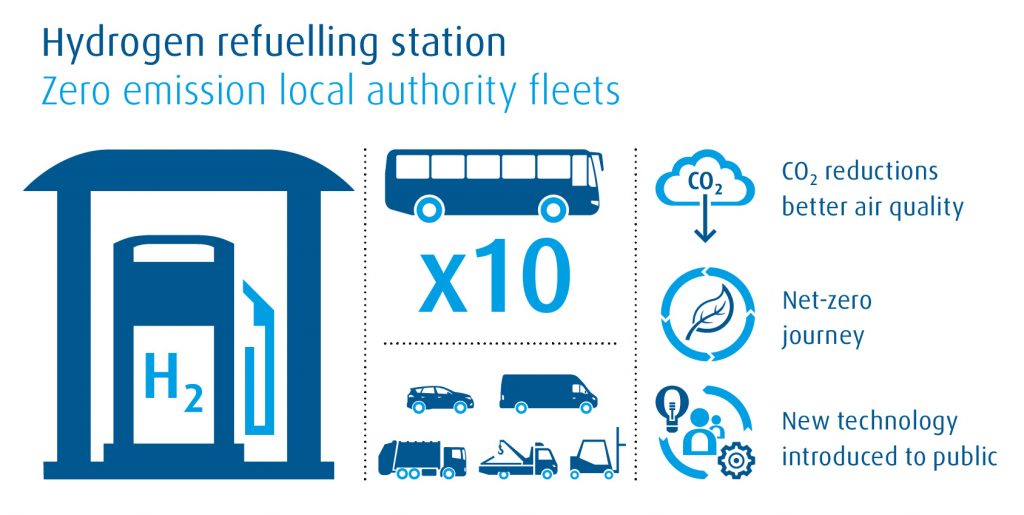 Hydrogen Refuelling Station Location
As well as having a location for vehicles to access dispensing pumps, a refuelling station will need space to store the hydrogen and an electrolyser to produce it. However, the area needed is typically no bigger than a traditional petrol forecourt. Layouts can be designed to fit almost any space and sites can be safely located adjacent to residential areas, if required.
Green hydrogen
To produce green hydrogen, you need renewable energy. BOC works with customers to source renewable power from a suitable supplier.
Safety
Hydrogen refuelling stations are safe. You must of course ensure appropriate safety distances from nearby assets, but this can be calculated and built into the engineering design. Hydrogen storage vessels are purpose built and designed to maintain pressures at optimal, safe levels and pumps are designed to ensure a safe connection between the dispenser and vehicle – with effective system safety checks every time hydrogen is dispensed. BOC has been producing hydrogen for over 100 years and it’s parent company, the Linde Group, has designed and installed over 200 hydrogen refuelling stations worldwide.
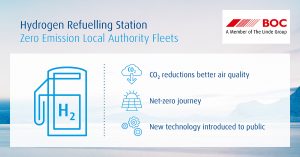 Timescales Timescales
Typical total build time is around 15-18 months. This allows for planning permission, civil engineering works, construction and commissioning.
Demonstrating success
When Aberdeen City Council wanted to develop a cleaner public transport network, it worked with BOC to develop, install and operate a tailored, state-of-the-art hydrogen refuelling station. The facility, based at the Kittybrewster bus depot, produces green hydrogen from electrolysis on site, and supplies a fleet of buses that travel up to 350km each day. Kittybrewster is now accessible to all hydrogen-fuelled vehicles, including double decker buses and private vehicles.
Moving forward
Opting for hydrogen refuelling to decarbonise your transport fleets is simpler than you think. By putting modular infrastructure in place it’s possible to scale up, share costs and help other fleet operators decarbonise their vehicles too. The first step is to find the right partner. A good hydrogen fuel specialist should be able to manage the whole project, from assessing specific transport and infrastructure needs to advising on funding, design and development of the facility. It could even operate and maintain it for you.
If you’d like to find out more you might find BOC’s guide to Decarbonising Transport with Hydrogen Hubs a useful resource. It contains all the information in this article – and more – in a handy PDF format.
|
NEED AN UP TO DATE DATABASE? 
|









 Digitising hospitals was the focus of NHS IT policy for twenty years. The job is still unfinished: so what are the options for trusts – and the integrated care systems that are planned to take over health tech strategy and funding next April? The Highland Marketing advisory board asked three leading chief information officers for their views.
Digitising hospitals was the focus of NHS IT policy for twenty years. The job is still unfinished: so what are the options for trusts – and the integrated care systems that are planned to take over health tech strategy and funding next April? The Highland Marketing advisory board asked three leading chief information officers for their views. 
 Highland Marketing’s advisory board: Jeremy Nettle, former global advisor for Health Sciences, Oracle Corporation; Cindy Fedell, former chief digital and information officer at Bradford Teaching Hospitals NHS Foundation Trust; Andy Kinnear, former director of digital transformation at NHS South, Central and West Commissioning Support Unit; James Norman, healthcare CIO, EMEA, at DellEMC; Ravi Kumar, health tech entrepreneur and chair of ZANEC, and Rizwan Malik, divisional medical director of Bolton NHS Foundation Trust and managing director of South Manchester Radiology
Highland Marketing’s advisory board: Jeremy Nettle, former global advisor for Health Sciences, Oracle Corporation; Cindy Fedell, former chief digital and information officer at Bradford Teaching Hospitals NHS Foundation Trust; Andy Kinnear, former director of digital transformation at NHS South, Central and West Commissioning Support Unit; James Norman, healthcare CIO, EMEA, at DellEMC; Ravi Kumar, health tech entrepreneur and chair of ZANEC, and Rizwan Malik, divisional medical director of Bolton NHS Foundation Trust and managing director of South Manchester Radiology  By Sascha Giese, Head Geek™ at
By Sascha Giese, Head Geek™ at 















 Timescales
Timescales



Recent Comments